Key takeaways:
- Energy-efficient lighting, such as LEDs, reduces electricity bills and has a longer lifespan (up to 25,000 hours), which benefits both the environment and reduces waste.
- Switching to energy-efficient bulbs lowers heat output, enhances home comfort, and minimizes maintenance costs due to infrequent bulb replacements.
- Choosing the right wattage involves understanding lumens for brightness rather than just wattage for energy consumption, allowing for tailored ambiance in different spaces.
- Proper installation and maintenance, including cleaning bulbs and using compatible dimmers, are essential for maximizing the longevity and performance of energy-efficient lighting.
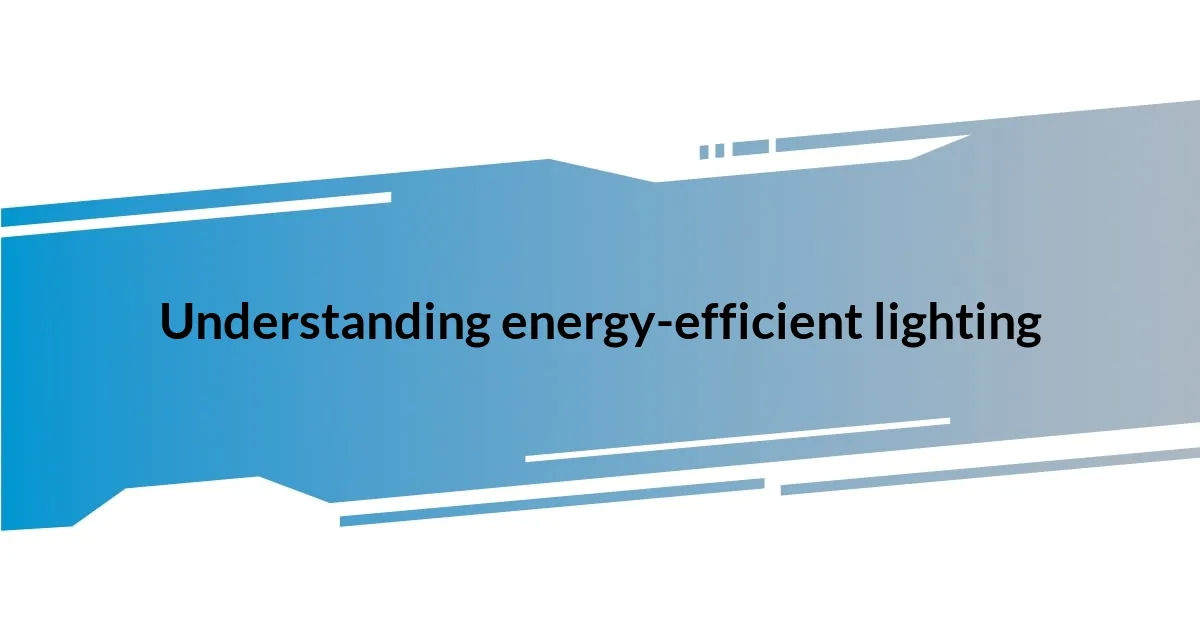
Understanding energy-efficient lighting
Energy-efficient lighting encompasses technologies that use less energy to produce the same amount of light compared to traditional options like incandescent bulbs. For instance, when I switched my home lighting from incandescent to LED, the drop in my electricity bill was truly eye-opening. Have you ever felt that rush of satisfaction when seeing a lower utility bill? It’s like finding an unexpected treasure!
One key aspect is the longevity of these bulbs. Many energy-efficient lights can last up to 25,000 hours or more, which means fewer trips to the store and less waste in landfills. I remember the last time I had to replace a bulb—it seemed like an endless cycle of buying and disposing. Doesn’t it feel rewarding to invest in products that not only save money but also contribute to a healthier planet?
Additionally, energy-efficient lighting can greatly enhance the atmosphere of our spaces. The bright, crisp light from LEDs transformed the ambiance of my office, making it feel more inviting and productive. Have you noticed how certain lighting can brighten your mood and even inspire creativity? It’s fascinating how something as simple as light can influence our daily lives so profoundly.
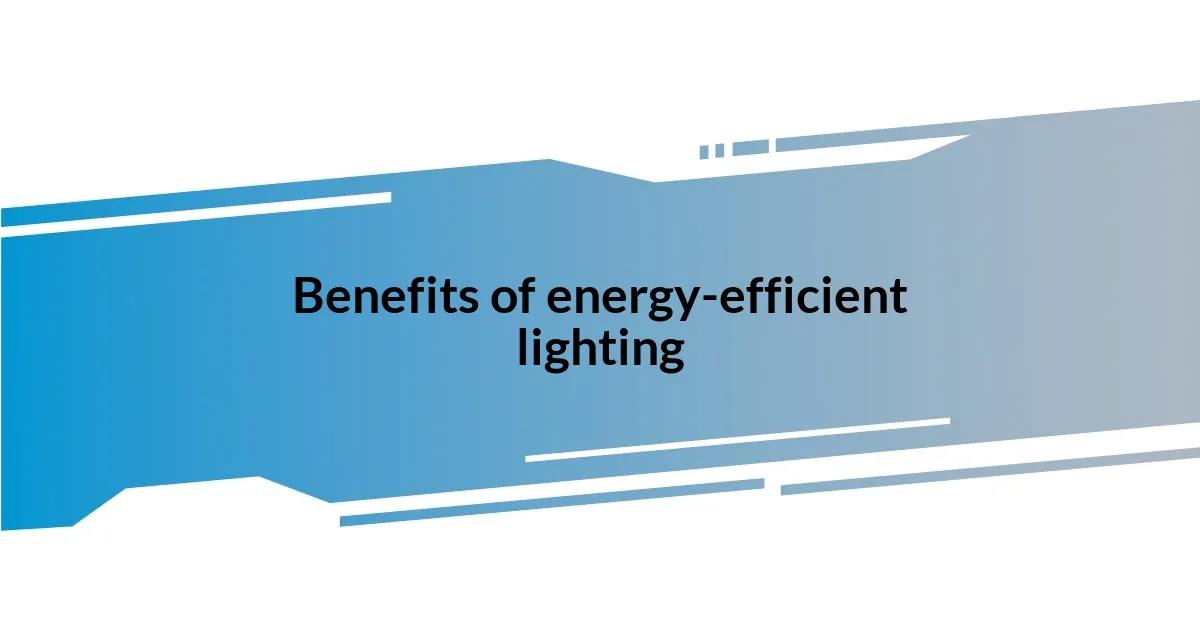
Benefits of energy-efficient lighting
Energy-efficient lighting offers numerous advantages that go beyond just saving money. One of the most compelling benefits I’ve experienced is the immediate impact on my carbon footprint. After making the switch, I felt a sense of empowerment knowing that my small action contributed positively to the environment. Have you ever reflected on how individual choices can collectively make a big difference? It’s rewarding to think you’re part of a larger solution.
Another great benefit is the reduced heat output from energy-efficient bulbs. I remember a sweltering summer day when my home felt unbearably hot after running my traditional bulbs. Switching to LEDs not only lowered my electric bill but also kept my living space cooler. Isn’t it a relief when you find a solution that tackles more than one issue?
Furthermore, energy-efficient lighting can significantly reduce maintenance costs. I recall the frustration of frequently having to replace burnt-out bulbs in my old fixtures. With LEDs, I’ve barely had to think about changing bulbs. It’s liberating knowing that I can set and forget—a small change that brings a lot of peace of mind!
| Aspect | Traditional Lighting | Energy-Efficient Lighting |
|---|---|---|
| Energy Consumption | Higher | Lower |
| Bulb Lifespan | 1,000 hours | 25,000+ hours |
| Heat Output | High | Low |
| Maintenance Frequency | Frequent | Infrequent |
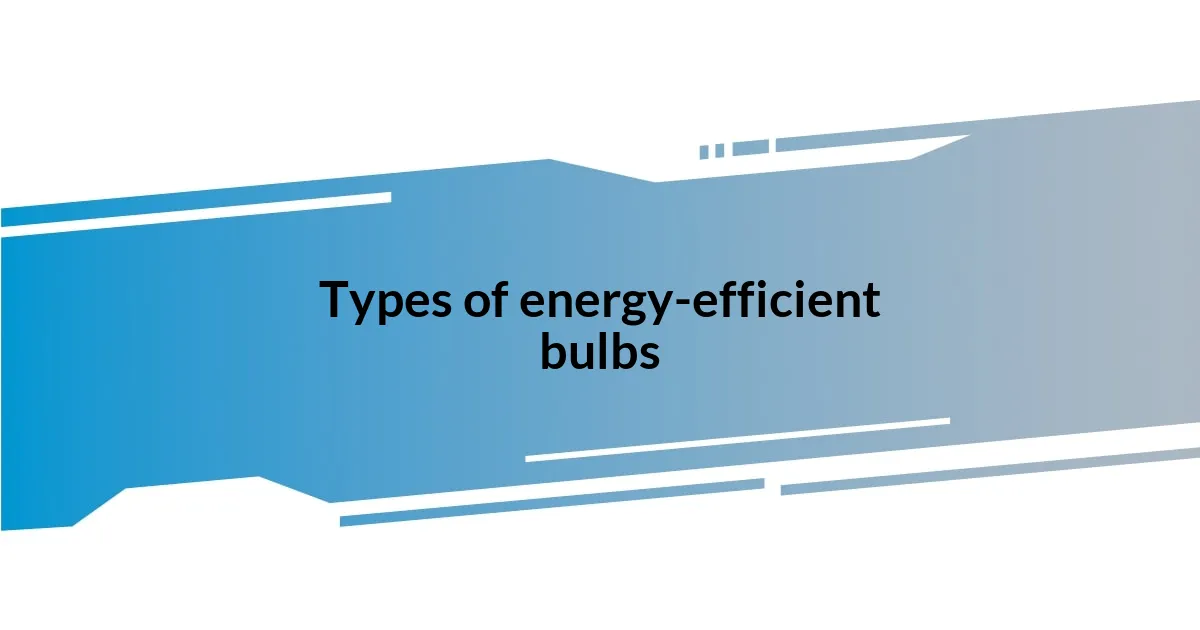
Types of energy-efficient bulbs
When it comes to energy-efficient bulbs, there are several types that can fit different needs and preferences. I remember my first encounter with compact fluorescent lamps (CFLs). They were a revelation to me, offering soft white light with significantly lower energy use than incandescent options. However, they do take a moment to reach full brightness, which I found a bit frustrating. Nowadays, I lean more towards LEDs. They turn on instantly, last for ages, and come in a variety of colors and styles that can really enhance a room’s vibe.
Here’s a quick rundown of the main types of energy-efficient bulbs:
- LED Bulbs: Known for their longevity and immediate brightness, perfect for just about any room.
- CFL Bulbs: A great option that uses about 75% less energy than incandescent bulbs but may have a slight delay in lighting up.
- Halogen Bulbs: A type of incandescent bulb that’s more energy-efficient but still gives off quite a bit of heat.
- Smart Bulbs: These are energy-efficient and offer convenience through mobile or voice control, allowing for customizable lighting settings.
I still find it fascinating how each type brings something unique to the table. Whether you’re looking for efficiency, aesthetics, or smart tech capabilities, there’s definitely an option that resonates with you. What’s been your experience with different types of bulbs?
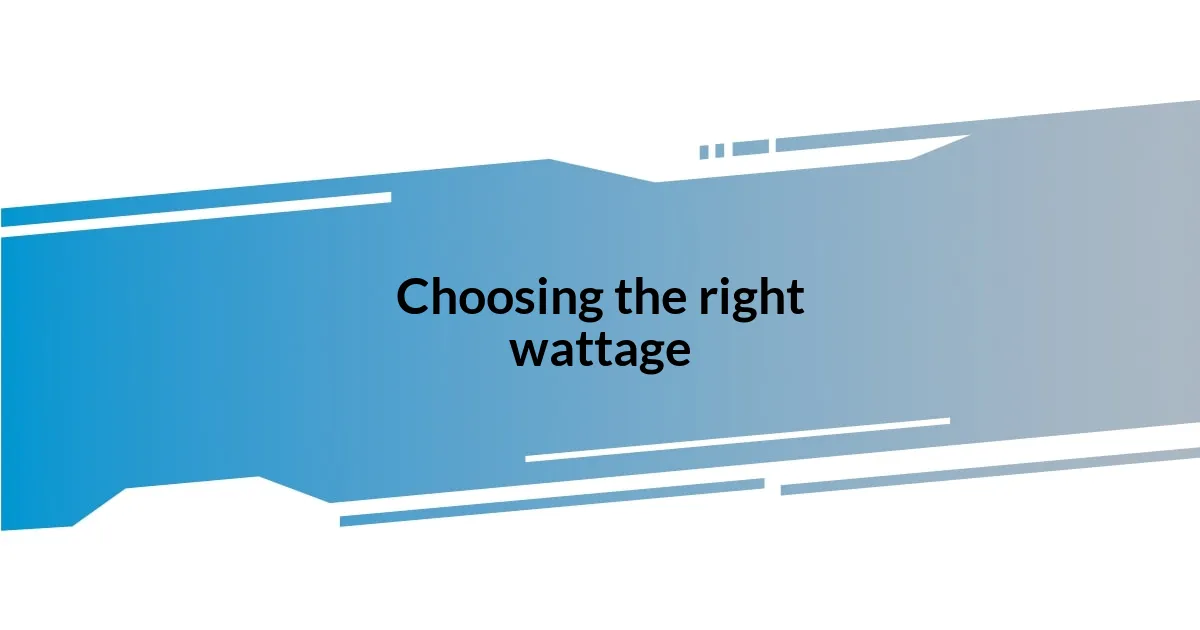
Choosing the right wattage
When it comes to choosing the right wattage for your lighting, it’s essential to consider both brightness and efficiency. I recall the first time I switched to LED bulbs; I was surprised at how much less wattage they needed for the same brightness as my old incandescent bulbs. It was astonishing to realize that a mere 10-watt LED could illuminate my living room just as brightly as a 60-watt incandescent. Have you encountered a similar revelation when adjusting your lighting choices?
It’s important to remember that wattage measures energy consumption, not brightness. To help visualize this, I often refer to lumens, which is the actual measure of light output. For instance, if you’re aiming for a cozy ambiance in your reading nook, choosing a bulb with around 800 lumens gives you a pleasant glow without overwhelming brightness. Personally, I find that balancing wattage with lumens allows me to tailor the atmosphere in my home perfectly.
Lastly, I’ve learned to be mindful about specific areas in my home where I need different wattages. In my kitchen, I prefer brighter lighting, so I go for something around 1,600 lumens, while in my bedroom, softer lighting with about 450 lumens creates a calming environment. Have you thought about how the right wattage can change the mood of your space? It’s these little adjustments that truly enhance the comfort of our daily lives.
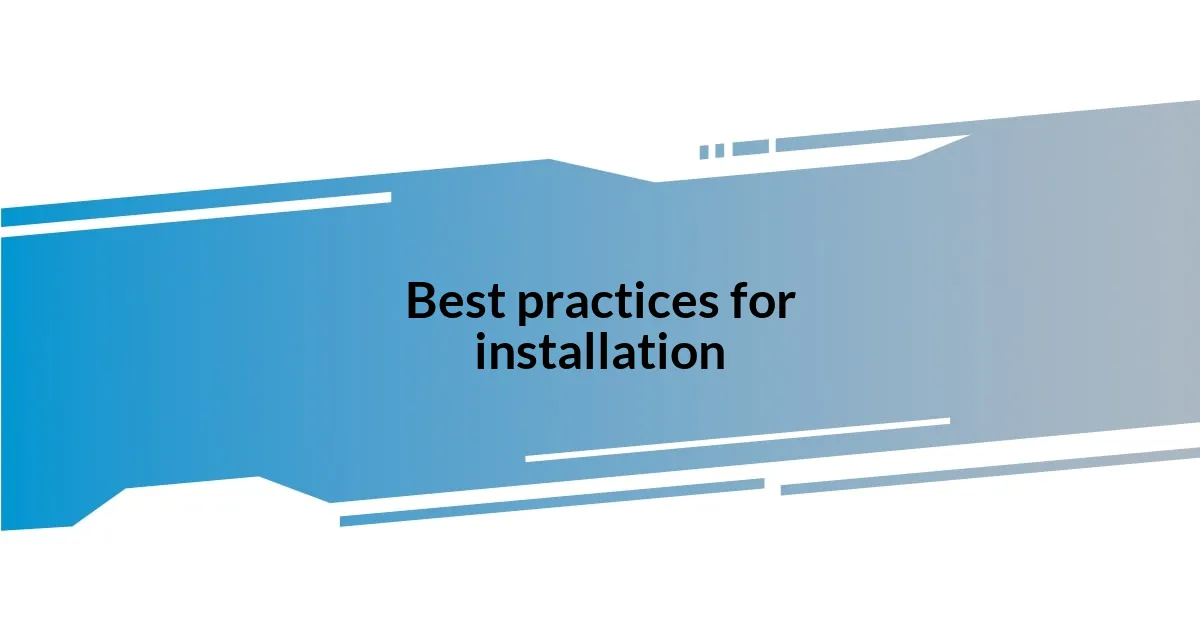
Best practices for installation
When installing energy-efficient lighting, I always prioritize safety first. I’ve encountered my fair share of frustrating moments due to improper installations, especially when I rushed through it to save time. Ensure that the power is turned off before starting anything. It just takes a moment, but this simple step can prevent accidents, making the process much smoother and stress-free.
One of my favorite best practices involves the strategic placement of fixtures. I remember sharing my lighting setup with a friend who had a dark corner in her living room. By simply adding an LED floor lamp in that spot, it transformed the space, creating a cozy reading nook. I always recommend thinking about where light is needed most in your home; proper placement can really enhance functionality while also elevating the overall ambiance.
Finally, don’t overlook the importance of following the manufacturer’s instructions. I once had a setback because I didn’t read through the guidelines for a smart bulb I had purchased; it took me longer than expected to troubleshoot. Each product has its quirks and features, so taking the time to understand them can save you headaches down the line. What about you? Have you ever skipped instructions only to wish you hadn’t later on? It’s worth the effort for a smooth installation outcome.
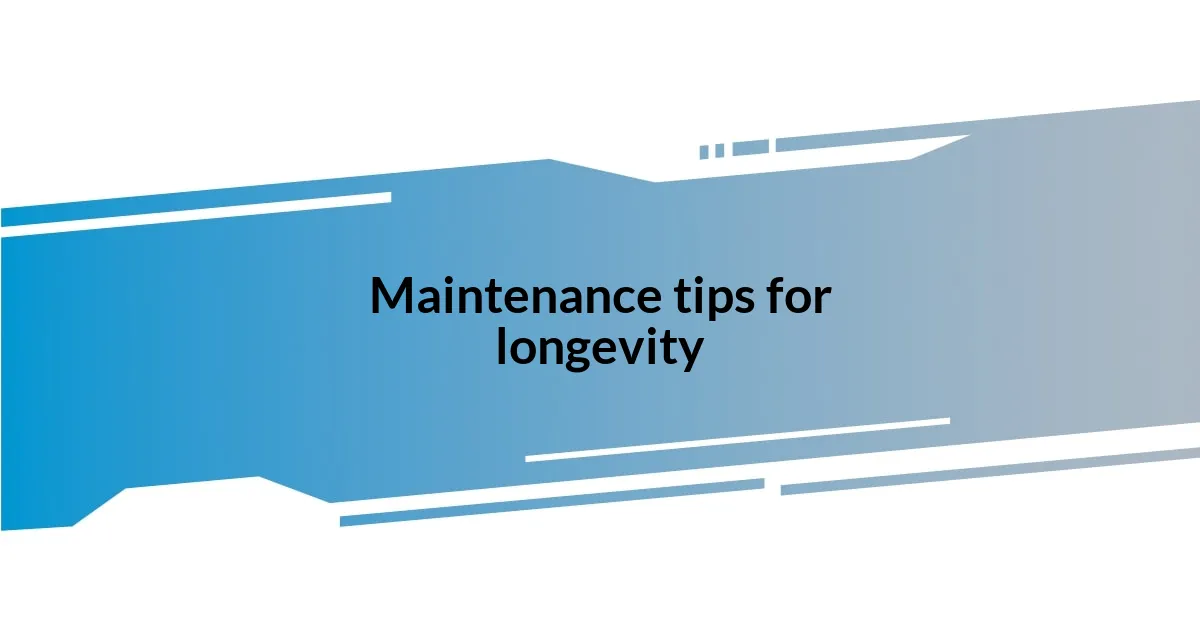
Maintenance tips for longevity
Maintaining energy-efficient lighting isn’t just about enjoying the savings; it’s also about longevity. I remember when I first started using LED bulbs, I had no idea that cleaning them regularly could significantly extend their lifespan. Dust and grime can accumulate on the surface, dimming their brightness over time. A soft cloth to wipe them down every few months? It seems so simple, yet it makes a huge difference!
Another tip that I’ve picked up along the way is to avoid using dimmers that are not compatible with LED bulbs. I learned this the hard way when my lights started flickering unexpectedly. It turned out the dimmer switch I had was designed for incandescent bulbs. After switching to a compatible dimmer, the flickering ceased, and my lighting experience became much smoother. Have you ever faced a similar compatibility issue? Finding the right components can transform the way your lighting performs.
Lastly, be vigilant about monitoring and replacing bulbs as needed. I had a moment of panic when an important meeting was about to start, and one of my key lights went out. It made me realize how crucial it is to keep an eye on the status of all my fixtures. Planning a routine check once every few months to see if any bulbs are nearing the end of their life can keep your spaces consistently well-lit. What strategies do you use to keep track of your lighting? It’s those little habits that can save us from surprises down the line.